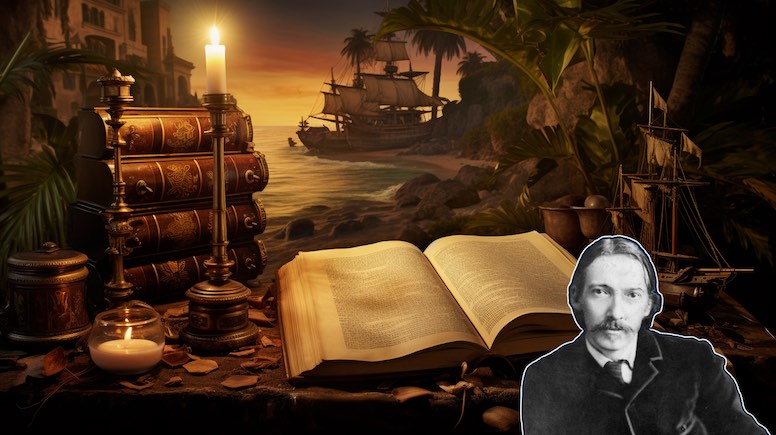Summary of the book “Treasure Island” by Robert Louis Stevenson
“Treasure Island” by Robert Louis Stevenson is an iconic adventure novel that has captivated readers since its publication in 1883. Set in the early 18th century, the story follows young Jim Hawkins as he embarks on a perilous journey to find buried treasure on a mysterious island. With its vivid portrayal of pirates, treachery, and bravery, “Treasure Island” has become a timeless classic that continues to enthrall readers of all ages.
The plot revolves around the discovery of an old map that leads to the location of Captain Flint‘s fabled treasure. As Jim sets sail with a crew of misfit sailors, he soon realizes that not everyone can be trusted.
Overview of the book “Treasure Island
“Treasure Island” by Robert Louis Stevenson is a classic adventure novel that takes readers on a thrilling journey filled with pirates, treasure hunts, and treacherous escapades. The story follows the young protagonist, Jim Hawkins, who sets sail on the Hispaniola in search of Captain Flint‘s hidden treasure. However, things quickly take a dangerous turn when he discovers that some members of the crew are actually pirates led by the cunning Long John Silver.
As the plot unfolds, Jim finds himself caught in a web of deceit and danger. He must navigate between loyalty and betrayal as he tries to outwit both the pirates and his own shipmates to secure the treasure for himself and his friends. Alongside this exciting narrative, “Treasure Island” delves into several key themes such as greed, moral ambiguity, and coming-of-age.
The theme of greed is evident throughout the book as characters are driven by their insatiable desire for wealth and power. From Long John Silver’s manipulations to Captain Flint‘s buried treasure itself, greed becomes an underlying force behind many actions within the story. Moreover, “Treasure Island” explores moral ambiguity through characters like Long John Silver who oscillates between being both villainous and sympathetic. Finally, this novel also serves as a coming-of-age tale for Jim Hawkins as he matures from an innocent boy into a brave young man through his experiences at sea.
Plot Summary:
“Treasure Island is an adventure novel written by Robert Louis Stevenson and published in 1883. The story revolves around Jim Hawkins, a young boy who discovers a treasure map among the belongings of a deceased pirate named Billy Bones. With the help of his friends, Dr. Livesey and Squire Trelawney, Jim sets off on a journey to find the hidden treasure on the notorious Skeleton Island.
As they embark on their journey, they hire a crew led by the enigmatic Long John Silver, who later reveals himself to be a treacherous pirate planning to seize the treasure for himself. The crew faces numerous obstacles and dangers along their way, including mutiny and encounters with rival pirates. Through wit and bravery, Jim manages to outsmart Silver and his crew while also discovering valuable lessons about loyalty, trustworthiness, and moral choices.
The key themes explored in Treasure Island include friendship versus betrayal, greed versus integrity, and the blurred lines between good and evil. Stevenson’s gripping narrative takes readers on an unforgettable voyage filled with suspenseful twists as well as thought-provoking insights into human nature.
Jim Hawkins discovers a treasure map
In Robert Louis Stevenson’s classic adventure novel, “Treasure Island,” the young protagonist Jim Hawkins stumbles upon a mysterious treasure map while working at his family’s inn. This unexpected discovery sets off a thrilling chain of events that will forever change Jim’s life. Entrusted with the knowledge of buried riches and fueled by his adventurous spirit, Jim embarks on a perilous journey to find the treasure.
As Jim delves deeper into his quest, he encounters an array of intriguing characters, including the cunning Long John Silver and the ruthless pirate crew. The treacherous voyage to Treasure Island becomes a test of wits and survival for Jim as he navigates through dangerous situations and learns to trust his instincts. The discovery of the treasure map not only serves as a catalyst for Jim’s physical adventure but also symbolizes the theme of hidden opportunities in life. Through this subtopic, readers can explore how chance encounters and unexpected discoveries can lead to exciting adventures with potentially life-changing outcomes.
Characters:
In Robert Louis Stevenson’s classic adventure novel “Treasure Island,” the characters play a crucial role in driving the plot forward and embodying key themes. The protagonist, Jim Hawkins, is a young and impressionable boy who finds himself caught up in a thrilling treasure hunt after discovering a map to Captain Flint‘s hidden booty. He represents innocence and vulnerability as he navigates the dangerous world of pirates and learns valuable lessons about bravery, loyalty, and self-discovery.
Long John Silver, the iconic pirate with a peg leg and a parrot on his shoulder, is perhaps one of literature’s most memorable characters. Cunning and charismatic, Silver personifies moral ambiguity as he switches allegiance between the pirates and Jim’s crew throughout the story. His complex nature adds depth to the narrative by challenging readers’ preconceived notions about good versus evil.
Another notable character is Captain Smollett, an experienced sailor who embodies discipline and order amidst chaos. As captain of Jim’s ship, Smollett represents authority but also exhibits compassion towards his crew members. His unwavering sense of duty towards completing their mission despite numerous obstacles highlights themes such as leadership, teamwork, and perseverance.
Overall, “Treasure Island” showcases Stevenson’s skill in crafting diverse characters that contribute to both the plot development and exploration of important themes such as morality, loyalty, courage, and leadership.
Jim Hawkins, Long John Silver, Captain Smollett
Jim Hawkins, Long John Silver, and Captain Smollett are three key characters in the classic adventure novel “Treasure Island” by Robert Louis Stevenson. Jim Hawkins is a young boy who works at his family’s inn, the Admiral Benbow. His life takes an unexpected turn when a mysterious sailor named Billy Bones arrives at the inn and entrusts him with a treasure map. This sets Jim on an exciting journey filled with danger and intrigue.
Long John Silver is one of the most memorable characters in the book. Initially posing as a friendly ship’s cook, he reveals his true colors as a cunning pirate seeking to steal the treasure for himself. Despite his villainous nature, Long John Silver also displays complex traits such as loyalty and resourcefulness.
Captain Smollett serves as the captain of the Hispaniola, the ship that carries Jim and his companions to Treasure Island. He is depicted as a stern but competent leader who tries to maintain order amidst mutiny and treachery. His unwavering commitment to duty makes him an important figure in navigating through various challenges faced by the crew.
Overall, these three characters play significant roles in shaping both the plot development and underlying themes of “Treasure Island.” From Jim’s coming-of-age journey to Long John Silver’s portrayal of moral ambiguity and Captain Smollett’s steadfastness, each character provides depth and substance to this timeless tale of adventure on the high seas.

Key Themes:
“Treasure Island” by Robert Louis Stevenson is a classic adventure novel that tells the story of Jim Hawkins, a young boy who embarks on a thrilling journey in search of hidden treasure. Set in the 18th century, the plot revolves around the mysterious map Jim discovers that reveals the location of Captain Flint‘s buried treasure. As he sets sail with Long John Silver and a crew of pirates, Jim soon learns about the dangers and treachery that come with his newfound wealth.
One key theme explored in “Treasure Island” is greed and its consequences. Throughout the novel, characters such as Long John Silver are driven by their insatiable desire for gold and riches. This theme highlights how greed can corrupt individuals and lead to their downfall. Another important theme is deception and trustworthiness. The novel showcases how appearances can be deceiving, as characters like Long John Silver present themselves as friendly allies while harboring ulterior motives. “Treasure Island” reminds readers to question others’ intentions before placing blind trust.
Overall, “Treasure Island” offers an exciting adventure filled with themes that explore human nature. Stevenson skillfully weaves together these key themes to create a captivating narrative that has stood the test of time, making it an enduring favorite among readers of all ages.
Adventure, greed, loyalty, coming-of-age
In the classic adventure novel “Treasure Island” by Robert Louis Stevenson, the story follows young Jim Hawkins as he embarks on a thrilling journey filled with treacherous pirates, hidden treasure, and the ultimate test of loyalty. After coming across an old sailor named Billy Bones, Jim discovers a map to Captain Flint‘s buried treasure. This sets in motion a series of events that lead him to board the Hispaniola ship alongside Long John Silver and his crew of menacing pirates.
As Jim navigates this dangerous world, he must navigate not only physical obstacles but also moral dilemmas. The theme of greed is prevalent throughout the novel as characters such as Long John Silver are driven by their desire for wealth and power. At the same time, Jim’s unwavering loyalty to his friends shapes his character development and emphasizes the importance of trust and honor.
Through his experiences on Treasure Island, Jim undergoes a coming-of-age transformation. He learns valuable lessons about bravery, resourcefulness, and resilience in order to outwit the treacherous pirates who will stop at nothing to claim Captain Flint‘s treasure for themselves. As readers follow Jim’s journey from innocence to maturity, they are reminded that true adventure lies not only in discovering treasure but also in uncovering one’s own inner strength and courage.
Analysis of the Plot:
“Treasure Island” by Robert Louis Stevenson is an adventure novel that follows the journey of young Jim Hawkins as he sets out to find a hidden treasure. The plot revolves around Jim’s encounter with the mysterious pirate Long John Silver and his crew, who are also in pursuit of the treasure. As Jim becomes entangled in their dangerous exploits, he must navigate treacherous waters and face various obstacles to survive.
One key theme explored in the plot is the idea of greed and its consequences. Throughout the story, it is evident that both Long John Silver and Captain Flint, who buried the treasure on Treasure Island, were consumed by their desire for wealth. This obsession ultimately leads to their downfall as they engage in deceit, betrayal, and even murder. The plot serves as a cautionary tale against allowing greed to cloud one’s judgment or drive them towards immoral actions.
Another important aspect of the plot is the coming-of-age journey undertaken by Jim Hawkins. At the beginning of the story, Jim is just an innocent boy working at an inn with no experience of life beyond his small village. However, as he embarks on this thrilling adventure, he undergoes a transformation into a brave and resourceful young man. Through encounters with pirates and facing perilous situations head-on, Jim learns valuable lessons about loyalty, trustworthiness, and self-discovery.
Action-packed journey to find buried treasure
In “Treasure Island” by Robert Louis Stevenson, readers embark on an action-packed journey to find buried treasure alongside the young protagonist Jim Hawkins. The story begins when Jim discovers a treasure map hidden in the belongings of a deceased pirate. Fueled by curiosity and the allure of untold riches, Jim sets off on an adventure to locate the buried loot.
Accompanied by a crew of seafaring misfits, including the infamous Long John Silver, Jim faces numerous obstacles and dangers along the way. From treacherous storms at sea to encounters with bloodthirsty pirates, each step brings them closer to their ultimate goal. As they navigate through uncharted territories and encounter rival treasure hunters, tensions rise and alliances are tested.
Throughout this thrilling quest for hidden riches, key themes emerge in “Treasure Island.” One significant theme is the contrast between appearances and reality. Characters like Long John Silver skillfully manipulate others with their charming personas while harboring ulterior motives. Loyalty is another central theme explored as friendships are put to the test amidst dangerous circumstances where trust becomes scarce.
In conclusion, “Treasure Island” takes readers on an electrifying adventure filled with danger, suspense, and unexpected twists. As young Jim Hawkins embarks on his quest for buried treasure alongside a colorful cast of characters, he learns valuable lessons about trust and appearances versus reality. With its gripping plot and timeless themes, this classic novel continues to captivate audiences seeking tales of high-seas adventure and hidden fortunes.
Significance of the Key Themes:
One of the key themes in “Treasure Island” is the conflict between good and evil. Throughout the book, this theme is evident in the characters of Long John Silver and Jim Hawkins. Long John Silver, although initially perceived as a friendly and trustworthy character, reveals his true nature as a cunning and treacherous pirate. On the other hand, Jim Hawkins represents goodness and loyalty as he remains steadfast in his quest for treasure while also remaining morally upright.
Another significant theme in “Treasure Island” is the exploration of adventure and its consequences. The entire plot revolves around a thrilling treasure hunt that takes readers on an exciting journey filled with danger and excitement. However, Stevenson also highlights the consequences of such adventures, as they often come with sacrifices and loss. This theme is demonstrated through characters like Captain Flint, whose greed for wealth ultimately leads to his demise.
Overall, these key themes serve to enhance the plot of “Treasure Island” by providing depth to characters’ motivations and actions while exploring ideas relevant to human nature such as morality, ambition, and consequence.
Exploring human nature and moral choices
In “Treasure Island” by Robert Louis Stevenson, the plot revolves around young Jim Hawkins, who discovers a treasure map and embarks on an adventure to find the buried wealth. Throughout the story, the characters are faced with numerous moral choices that shed light on human nature. One key theme highlighted is the duality of human behavior – the struggle between good and evil.
Captain Long John Silver serves as an embodiment of this theme, appearing friendly and trustworthy while secretly plotting against his crewmates. Stevenson explores how individuals can easily deceive others for their own gain, emphasizing that appearances can be deceiving. Moreover, Jim’s journey forces him to confront his own moral choices when he discovers that some members of his crew are willing to kill in order to secure the treasure for themselves. This dilemma raises questions about human nature and whether self-interest or morality prevails in high-stakes situations.
Overall, “Treasure Island” delves into human nature through its exploration of moral choices made by various characters. Stevenson reminds readers that people may not always act in accordance with societal expectations or personal values when tempted by power or wealth. By examining these ethical dilemmas within a thrilling adventure narrative, he prompts us to consider our own capacity for both good and evil in our decision-making processes.
Conclusion:
In conclusion, “Treasure Island” by Robert Louis Stevenson is a thrilling adventure novel that captivates readers with its fast-paced plot and vivid characters. The story follows young Jim Hawkins as he embarks on a treasure hunt after discovering a mysterious map. Along the way, he encounters pirates, mutiny, and treacherous seas.
One of the key themes in the book is the battle between good and evil. This is exemplified through the character of Long John Silver, a charming yet deceitful pirate who manipulates those around him for his own gain. Stevenson explores the moral ambiguity of characters like Silver, blurring the lines between right and wrong.
Another prominent theme is coming-of-age and self-discovery. Jim Hawkins undergoes significant growth throughout his journey, learning valuable lessons about trust, loyalty, and bravery. His experiences shape him into a courageous young man who ultimately triumphs over adversity.
Overall,”Treasure Island” is an enduring classic that continues to enthrall readers with its timeless themes of adventure, morality, and personal growth. Stevenson’s masterful storytelling combined with memorable characters make this book an essential read for any lover of adventure literature.
Impact of “Treasure Island” on literature and readers.
“Treasure Island,” written by Robert Louis Stevenson, is a classic adventure novel that has had a profound impact on both literature and readers. The story follows young Jim Hawkins as he embarks on a perilous journey to find buried treasure. Throughout the book, Stevenson skillfully weaves together themes of greed, loyalty, and the search for identity.
One key theme in “Treasure Island” is the corrupting power of greed. From the moment Jim discovers the treasure map, it becomes clear that this quest for riches will have dire consequences. Characters like Long John Silver and Israel Hands exemplify this theme as they let their desire for wealth consume them, leading to betrayal and violence.
Another significant theme in “Treasure Island” is loyalty. The relationship between Jim Hawkins and Long John Silver highlights both loyalty’s strength and its fragility. While Silver initially befriends Jim to further his own agenda, their bond evolves throughout the story as Jim grapples with his conflicting loyalties to both Silver and his companions.
These themes contribute to the enduring impact of “Treasure Island” on literature and readers alike. Stevenson’s masterful storytelling continues to captivate audiences today, reminding us of the timeless lessons embedded within this thrilling adventure tale.












